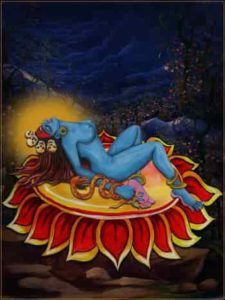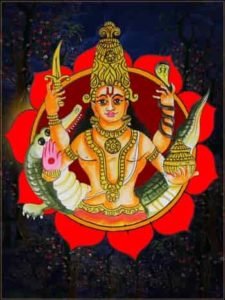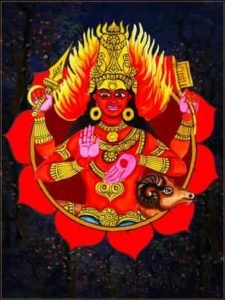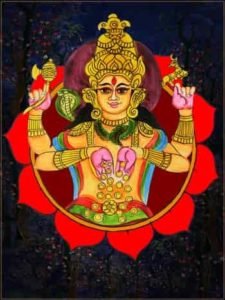Hevajra is one of the most prominent deities of Kapalika, Left hand tantra (vama marga), Aghora and Vajrayana tradition. He is a deity who is believed to tie the entire above mentioned sect into one garland of Rudra Tantra. Hevajra is considered to be one of the forms of Rudra as the word ‘Hevajra’ is nothing but a salutation to Mahakala Rudra in his vajra form.
Furthermore, Hevajra is a deity who like Vajra Yogini is also the deity of vama and tamas path combined. Hevajra basically is the amalgamation of vama marga (left hand path) and tamas marga.
Etymology
The word ‘Hevajra’ is composed of two words, ‘He’ – salutation and ‘vajra’ denotes the epitome of vajra because the Mahakala’s body is believed to be made from six vajras. Hevajra is the manifestation of Mahakala. So, the word Hevajra denotes salutation to vajra and vajra means Mahakala Rudra because Hevajra manifested from his body.
Iconography
As per ‘Siddha Dharma’, Hevajra is portrayed as a wrathful deity with blue color complexion. He is portrayed with his consort Nairatmya. He holds 16 skull cups and each skull cup contains divine animals and gods.
The Hevajra is portrayed with 8 heads and all of them radiate wrath. Their hairs are portrayed as flying upwards. Like other tantric deities, he wears the garland of 51 freshly severed heads.
As per ‘Siddha Dharma’, Hevajra is not portrayed with any shastra(scriptures) and ashtras (weapons) unlike other tantric deities. As per the philosophy of the Hevajra, the greatest shastra and ashtray is nothing but a human mind. Therefore, he is portrayed as holding 16 skulls.
1) Left hands of Hevajra
As per “Siddha Dharma”, Hevajra’s left hand’s khappar hold 7 skulls which has 7 divine animals in them. In the public domain, Hevajra is portrayed as having 7 animals in his skull cap which is plain wrong. The 7 animals are not animals at all. They are 7 avataras and divine personalities and they all represent the divine energy and powers related to their respective deities. The 7 divine animals are as follows:
- The ‘Ulluka’ or the owl which is also the vahana of Mahalaxmi. It denotes abundance, prosperity and fulfilment.
- The ‘Red Raging Bull’ is also the symbolic representation of tantric Mahasiddha Nandi Nath. The tantric Nandi is the epitome of agama-nigama wisdoms.
- The ‘Red human’ is the symbolic representation of normal passionate human being. As per tantra, humans are considered to be pashu at initial stages and after the mastery over pashutva and attainment of “devatva”, the human becomes devta and after transcending the “devta”, “Shivatva” is attained.
- The ‘Grey Donkey’ is the symbolic representation of Goddess Kala Ratri.
- The ‘Camel’ is the symbolic representation of Ustra Vahini Devi.
- The ‘Blue Horse’ is the symbolic representation of the horse of Shambhala king, Kalki god. It also represents the tantric shaktis of Kalki bhagawana. It also symbolises great wisdom and power.
- The “Neela Hirana” or the blue deer is the symbolic representation of Sharabha’s vahana.
2) Right hands of Hevajra
As per “Siddha Dharma”, Hevajra’s right hand’s khappar are portrayed as holding seven gods and divine personalities. The 7 gods and divine personalities are:
- The “Red Fire God” is the symbolic representation of Lord Agni and the red color denotes his effulgence. It also
- The “Yellow God with Peacock” is the symbolic represenation of Lord Kumara and it denotes the commanding power, bravery and rajasic virtues.
- The “Black God” is the symbolic representation of Lord Yama and his inherent power of destruction.
- The “Yellow God” is the symbolic representation of Lord Kubera and the power of infinite wealth and abundance.
- The “White God” is the symbolic representation of Lord Chandra and the “Soma Rasa” which Hevajra drinks from his khappara.
- The “Golden God” is the symbolic representation of Lord Varuna and the power of all water related perfections.
- The “Sky Blue God” is the symbolic representation of Lord Pawana and the power of all air related perfections.
Furthermore, Kalaratri is portayed as sleeping down on her back and Mahakala Rudra is portrayed as lying on the ground with the support of the abdomen and chest because Hevajra and Vajra Yogini manifested when they had their respective position.
As per ‘Siddha Dharma’, Hevajra is portrayed as such with his consort Nairatmya so as to depict and insinuate that in the paintings, the aforementioned knowledges and spiritual powers of all those divine personalities are transferred to Hevajra through the his khappara and through him, Nairatma receives it.
Furthermore, the “Siddha Dharma” says that the mastery over Hevajra practice provides various perfections like “ashta siddha”, “five elements mastery”, “mastery over death”, “mastery over wealth” etc.
Different Forms of Hevajra
As per “Siddha Dharma”, Hevajra basically has four forms which are listed below.
1) Kaya Hevajra
As per “Siddha Dharma”, he is portrayed with two arms which holds a vajra and a khappara or a skull cup respectively. He is portrayed in dark blue with his consort Nairatma. Because of him having a vajra swaroop, he is also portrayed with khatvanga resting on his body which denotes his prowess and mastery over Vajrayana.
2) Vaka Hevajra
As per “Siddha Dharma”, he is portrayed with four hands, the two hands holding his consort Vajravarahi while the other two hands respectively holds a skull cup and a vajra. Khatvanga also is portrayed resting on his body.
3) Chitta Hevajra
As per “Siddha Dharma”, he is portrayed as Hevajra with 6 hands with three heads. The first two hands is portrayed as holding his consort, Vajrashrinkhala while the remaining 4 respectively hold vajra, knife, trident and a bell. He is also portrayed as standing on top of Mahakala Rudra’s heaps while the navel of Kalaratri.
4) Hridaya Hevajra
As per “Siddha Dharma”, the Hridaya Hevajra is the Vajra that we refer commonly because this is the most advanced and sophisticated form of Hevajra which is greatly revered and mostly worshipped among the forms of Hevajra.
Possessions of Hevajra
As per “Siddha Dharma”, there are some basics possessions of Hevajra and his practitioners. His practicioners should have in their possessions:
a) Vajra
It denotes mastery over Vajrayana and also Vajra Yogini,
b) Trishula with Damaru
It denotes veer bhava and Shaiv tradition. The Damaru denotes the use of nada for the perfection of khappara.
c) Hevajra Yantra
The yantra is a mandatory possession for the Hevajra practioner because the yantra contains two opposite triangle to form a shatakona (six triangles.) This also denotes the meeting of kundalini of ones body in the khappar of the kapalika.
d) Khappara (skull cup)
It denotes the brain of Kapalika, The skull cup is used as an instrument for drinking and eating purposes which is symbolic representation of drinking amrita from ones own sahastrahar kamal or crown chakra.
e) Narmunda with Moon on forehead
Hevajra like other tantric deity is also portrayed with a crescent moon on his forehead. The Narmunda depicts ones own head and moon on the forehead denotes the soma rasa or the amrita inside the head. Furthermore, the narmunda also symoolizes impermanence and death but with a moon on top denotes the mastery over death through soma rasa.
The origin story of Hevajra
As per ‘Siddha Dharma’, his origin is linked with the origin of Vajra Yogini. When Mahakala Rudra bent down to pose like a child crawling, his skins, flesh melted from his body and only his skeleton system was visible. From the skeletal system he manifests 6 vajra or the diamond jewel in the places where kundalini chakra are portrayed. The vajra also known as diamond jewel is so effulgent that it radiates light.
The six goddess manifests from his 6 vajras. One of them is Vajra Yogini. When Mahakala Rudra explains her about the form of Vajra Yogini through yogic dharana the rishi/munis also listens to their conversations. When upon the request of the Kala Ratri to manifest his kapalika form, Mahakala Rudra lifts his skeletal head and then the 7th vajra is manifested and witnessed by the rishi/munis. The seventh vajra is such effulgent that the rishi/munis are inept to view it with their naked eyes.
Therefore, they salute Mahakala Rudra as ‘He Vajra’ as a call for Mhakala Rudra to protect them from such effulgence. Simultaneously, Hevajra form also manifests from the body of Mahakala Rudra.
Philosophy of Hevajra
As per ‘Siddha Dharma’, Hevajra is a deity who is the highest deity of vama marga or the left hand path. Similarly he is also associated with the Kapalika therefore he holds Khappara in his hand. He is associated with Vajrayana as his name itself denotes the salutations of the Rishi/Munis while saluting Mahakala Rudra. Lastly, he is also an Aghora.
He is worshipped as the top most Kapalika because he exactly resembles the Kapalika but he differs with Kapalika while it comes to the path of perfection. The Kapalikas are only vama margi while he is the epitone of vama marga and tamas marga combined. Therefore, Hevajra is depicted as the biggest Kapali because of his mastery over other related disciplines.
He is also a topmost Aghora because Aghora is the path of tamas to perfection of Humans life. The Aghora tattwa adds the tamas path in the Hevajra practice.
He is portrayed as vama margi because he manifested when Mahakala Rudra and Kala Ratri were in their yogic union.
The ‘Siddha Dharma’ reveals that based on his attributes mentioned above, some of his core philosophies are:-
Mastery of the both material and spiritual world
The vama marga is the left hand path which denotes the mastery over disciplines, materials and spiritual discipline. The Hevajra is adept in both bhoga and moksha because left hand path is the path of bhoga and moksha combined. The “Siddha Dharma” therefore depicts him naked with his consort Nairatma as a way to represent mastery over bhoga and his bluish complexion to denote his mastery over moksha.
Kapala centric tantra
As per ‘Siddha Dharma’ revelations, Hevajra is also a Kapali, therefore, he puts the mind before everything. The mind is the center of all cognitions and experiences. The world is possible only because of the mind and its judgment. Hevajra considers the mind to be greatest of all greatest astras (weapons) or shastras (wisdoms). Hevajra is a deity who knows how to make the best use of his sahasrar kamala and live the ultimate life or the life of Shiva.
Therefore, ‘Siddha Dharma’ portrays him with 16 skull cups or khappara denoting mastery of the mind. He is believed to drink the universal wisdoms related to different gods and deities and their power in him through his Khappara. Therefore, Kapala is the sole possession of Hevajra.
The joint path of body and mind
As per “Siddha Dharma”, the path of Hevjra is the joint path of body and mind too. Hevajra holds khappar which denotes his mastery over all his mind and brain. The brain and mind are one and the same. They are like two rungs of a same ladder. To have a healthy mind, one should have a healthy body because the body is controlled by the mind. In reverse, if one wants to control the mind then the body should be controlled first.
Secondly, if one only uses the mind but not the body then the body weakens and the weakening of the body is the path of death. If the Kapalika do not master their body through the wisdom form of Deha Kaushalam then sooner or later the Kapalika will have to deal with weak body which in turn will create a weak mind and they very purpose of Kapalika is then defeated. Therefore, “Siddha Dharma” advocates the mastery of body first and then the mind. If body is mastered then the khappar is also mastered.
Skepticism
As per “Siddha dharma”, the skepticism is the main weapon of Kapalika and Hevajra. The Hevajra practitioner should be a dire skeptic because they should not believe anything without their own experience. They are sceptic at core because for them everything is encircled within “ashta pasha”. Ashta Pasha are eight modes of perception which the mind perceives the world and the existence around. The Kapalikas are sceptics to the whole sense information as well as everything happening around us. They do not trust anything except the khappar which has become perfected through sadhana and through this khappar they drink reality and information of the world.
Guru-disciple lineage of Hevajra
As per ‘Siddha Dharma’ the guru-disciple lineage of Hevajra is the same as Vajra Yogini lineage because the ‘Siddha Dharma’ doesn’t differentiate Hevajra from Vajra Yogini. The wisdom was transferred to Aghoreshwari Kurukulla from Swachand Bhairav. She then initiated many rishi/munis in this path in different variations of shakta variation, siddha variation, deva variation, naga variation etc.
Hevajra as Kapalika
As per ‘Siddha Dharma’, he is foremost kapalika because he was manifested from the body of Mahakala Rudra when Mahakala Rudra manifested the seventh vajra which was from the head region. After the salutation of ‘He Vajra’ by the seers and sages to Mahakala Rudra, Hevajra is believed to be manifested. So, he is believed to be foremost Kapali.
Hevajra as the deity of Vama Marga
As per ‘Siddha Dharma’, Vajra Yogini is the deity of vama and tamas marga combined. Since, Hevajra manifested in the act of manifestation of Vajra Yogini by Mahakala Bhairava or Mahakala Rudra and Kalaratri Bhairavi, he is also believed to be the deity whose path to perfection is vama marga or left hand path tantra. The Hevajra with his cosort Nairatma depicts him to be the deity of vama marga.
Hevajra as the Aghora
As per ‘Siddha Dharma’, he is also Aghora. He manifested from Aghoreshwara himself, Mahakala Rudra. His path can also be perfected through Aghora. As mentioned earlier, he is Aghora because his path also encompasses the tamas element. Furthermore, the wrathful expressions in his face, the bluish body and nakedness also depicts Aghora element.
Prominent Kapalikas
As per “Siddha Dharma”, there are some prominent Kapalikas. They are
1. Mahakapalika Khabbal Khaulika Maharaj
As per “Siddha Dharma”, he is considered to be one of the foremost Kapalika who contributed to his lineage about Kapala sadhana. He was taken under the tutelage of Kapala sadhana by Mahasiddha Brihaspati Nath and he later became a Mahakapalika by perfecting “Vajra Yogini”. He revitalised the Kapalika sect and added many wisdoms to it.
2. Mahasiddha Matsyendra Nath Ji Maharaj
As per “Siddha Dharma”, Mahasiddha Matsyendra Nath Ji is credited for revitalising and rejuvenating the Kapalika path to the public domain. He revived it by initiating various siddhas and also by reaching the society and initiating many common people to the lineage of Mahakapalika.
Hevajra Texts and Tantra
Mahakapalika Kalpa
The “Mahakapalika Kalpa” is the magnum opus of “Siddha Dharma” when it comes to book related to Kapalika. This book has 6 sections which are listed below.
Prathama Kapali Khanda
- Charmang Patala
- Shirang Patala
- Hridyang Patala
- Vyapakang Patala
- Vyadhirupang Patala
- Shuddirupang Patala
Dwitiya Kapali Khanda
- Kapali Kapalini Patala
- Kapala Mandala Patala
- Kapalopasana Patala
- Kapala Diksha Patala
- Kapala Nitya Krama Patala
- Kapala Deha Kaushal Patala
Tritiya Kapali Khanda
- Guhya Mudra Patala
- Guhya Bali Patala
- Guhya Sura Patala
- Guhya Dhumra Patala
- Guhya Mina Patala
- Guhya Bali Aahara Patala
Chaturth Kapali Khanda
- Ananda Kamachara Patala
- Ananda Kaumari Vadhu Patala
- Ananda Krur Shringara Charitra Patala
- Ananda Nada Patala
- Ananda Bhoj Patala
- Ananda Krida Patala
Pancham Kapali Khanda
- Kama Kautuka Dhyana Patala
- Kama Kautuka Dharana Patala
- Kama Kautuka Rasa Patala
- Kama Kautuka Shoonya Patala
- Kama Kautuka Samadhi Siddhi Patala
- Kama Kautuka Maha-anandaa Patala












